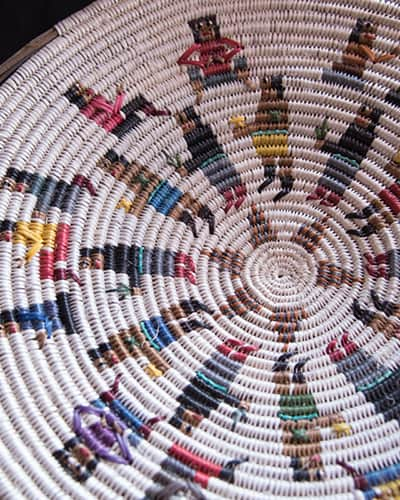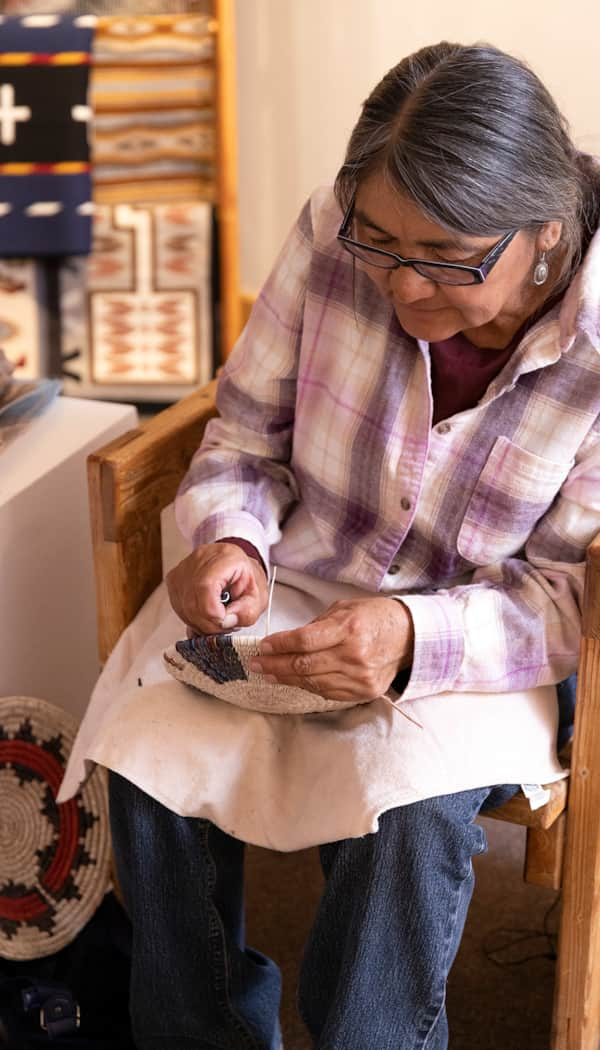The Navajo Basketmakers
Meet the Navajo artists behind this labor intensive and traditional practice.

Dye-stained and powerful hands keep a consistent pressure on the tight shape of a basket while simultaneously coiling and binding pliable sumac into designs that draw on tradition, birthplace and imagination. They alternate colors and sizes in the weave, gradually building out the design as the basket grows in size from the center outwards. The process continues for hours, days, weeks and sometimes months. These hands belong to the often unseen Navajo basketmakers of Southern Utah.
We wanted to get to know the artists behind the Navajo baskets, so we asked the brothers Barry and Steve Simpson of Twin Rocks Trading Post to hire a demonstration of the basketmaking. For a lot of travelers, Twin Rocks is a quick stopover in the tiny town of Bluff, Utah, an adventure outpost on the San Juan River, 45 miles east of Monument Valley Navajo Tribal Park.
Barry and Steve shuttle between the trading post and Twin Rocks Cafe next door. At any moment, Steve might be wiping down tables at the Cafe while Barry, behind the Trading Post’s counter, explains the craft of the Navajo baskets and other art and fine jewelry. Take time to ask the Simpsons questions. They’re proud advocates of contemporary Native American art, with decades of knowledge.
Much of what we learn about the basketmaking process comes from Joann Johnson. Her mother, Betty Rock Johnson, taught Joann to weave when she was 8 years old.
They’re called basketmakers, rather than basketweavers, because the complex process is much more than weaving. It encompasses creativity, hard work and the pride of producing it themselves. For many, it is their way of life.

Rich in history, the ceremonial baskets are imaginative and tightly woven — and very labor intensive. Before the weaving even begins, artists gather sumac (also called willow or squaw grass) from alongside irrigation ditches or waterways — it’s most pliable in the spring or fall and easier to shape without leaves.
The basketmakers typically gather truckloads of sumac at a time, sometimes heading up to the Green River and Moab areas. They cut it to size and split it three ways, this time with the help of their teeth. They remove the center of the ribbons of sumac, then set them aside to dry so they can peel off the skin later. Basketmakers achieve different sizes for their intricate designs by pulling the ribbons through a tin can lid with a variety of holes punched in it. They then dye the dried, split sumac, starting with the primary colors of traditional baskets: red and black. Joann shows us the very beginning of the basket, when she threads the split sumac through a starter coil she’s creating, wrapped around the unsplit rod foundations.
Now she can start weaving.
“The colors, when I’m working, just naturally come to me: what color’s going to come next, what’s going to look good. It just works, when I’m sitting sketching it with colored pencils. I look at rock formations, I look at shadows, I look at sunsets,” says Joann.
The Simpsons also called one of the matriarchs of the trade, Mary Holiday Black. The 81-year-old mother of 11 (nine of whom learned her craft) is a recipient of a National Heritage Fellowship Award from the National Endowment for the Arts. Many credit her with safeguarding the tradition and spurring its renaissance. Lorraine Black, an award-winning artist in her own right, accompanies her mother to Twin Rocks. They set up their weaving area against a backdrop of Navajo rugs, a bundle of raw sumac before them.
It isn’t until you watch Lorraine and Mary for a few minutes that you begin to comprehend the intricate process. It takes a masterful understanding of the craft to envision and carry out the final designs — from traditional ceremonial styles, butterflies, stylized animals to increasingly complex ideas and depictions.
The baskets hanging on the walls come alive as your brain begins to reverse engineer them. Your fingers ache from mimicking the position and the motion.
Though the artists often go unseen, occasionally there are opportunities to meet one of these extraordinary women. On the day we visit, one of the top innovators in modern-day Navajo basketmaking, Elsie Stone, happens to stop by on her 80-mile drive to her bank. She drops off a basket she has just finished. Respectfully, Barry Simpson admires the basket, which is a white owl woven into a blue basket. After writing a check to Elsie, he adds it to their wide-ranging collection. Elsie, like many of her peers, draws her sole livelihood from the trade. These high quality baskets are beautiful. But now we understand what they cost their creators in terms of time, effort and perseverance.
Story by Andrew Dash Gillman and photojournalist Sonya Doctorian.
What's Nearby
-

Bluff
Rich in human and natural history, Bluff is a central point along the Trail of the Ancients National Scenic Byway. It is a gateway to Monument Valley, Bears Ears National Monument, Valley of the Gods and Hovenweep National Monument.
-

Greater Cedar Mesa
The Cedar Mesa area encompasses up to 1.9 million acres and is home to more than 100,000 archaeological sites. For adventurers with a love of solitude, archaeology and geographic beauty, this area has it all.
-

Monument Valley Navajo Tribal Park
Monument Valley, Utah, an iconic symbol of the American West, is the sacred heart of the Navajo Nation and the ideal setting for your next adventure in the warm, high desert climate of southeastern Utah.












